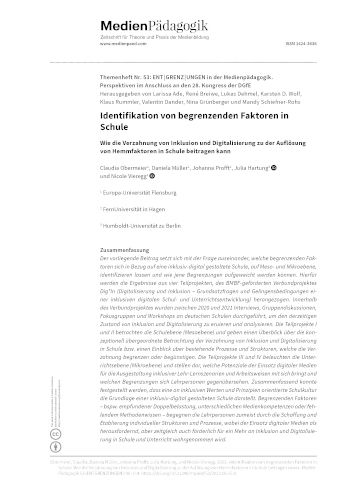Abstract
The focus of this article is to identify limiting factors in relation to an inclusive digitally designed school and how they can be overcome. Therefore, the results from the four subprojects of the BMBF-funded joint project Dig*In (Digitalization and Inclusion – Key questions and felicity conditions in inclusive and digital school and teaching development) are consulted. Within the joint project, interviews, group discussions, focus groups and workshops were conducted at german schools between 2020 and 2021 to investigate and analyze the current state of inclusion and digitization. Subprojects I and II focused on the school level (meso level) and provide an overview of the conceptual consideration of inclusion and digitization in school and an insight into the existing processes and structures of the implementation process. Subprojects III and IV focused on the teaching level (micro level) and illustrate the potential that the use of digital media offers for developing inclusive teaching and learning scenarios, and which limitations teachers have to overcome. It is evident, the basis of an inclusive digital school is a school culture oriented toward inclusive values and principles. Limiting factors are: different media competencies or a lack of methodological knowledge. Creating and establishing individual structures and processes teachers overcome these limitations. The use of digital media can be beneficial for the successful implementation of inclusion and digitization in schools and class yet also a challenge.
References
Büker, Petra, Anna-Maria Kamin, Katrin Glawe, Jana Herding, Insa Menke, und Franziska Schaper. 2022. «Inklusions- und digitalisierungsbezogene Kompetenzanforderungen in der Lehrkräftebildung verzahnen: Theoretische und konzeptionelle Grundlagen der Lehr-/Lernumgebung inklud.nrw». Herausforderung Lehrer*innenbildung – Zeitschrift zur Konzeption, Gestaltung und Diskussion 5 (1): 337–55. https://doi.org/10.11576/hlz-5960.
Dimitrijević, Sonja, Jelena Jovanović, und Vladan Devedžić. 2015. «A comparative study of software tools for user story management». Information and Software Technology 57: 352–68. https://doi.org/10.1016/j.infsof.2014.05.012.
Falvo, David A., und Michael Urban. 2007. «W. Lidwell, K. Holden and J. Butler: Universal Principles of Design». Education Tech Research Dev 55 (3): 297–300. https://doi.org/10.1007/s11423-007-9036-7.
Filk, Christian. 2019. «‹Onlife›-Partizipation für alle! – Plädoyer für eine inklusiv-digitale Bildung». In Schule digital – wie geht das? Wie die digitale Revolution uns und die Schule verändert, herausgegeben von Olaf-Axel Burow, 62–82. Pädagogik. Weinheim, Basel: Beltz.
Filk, Christian, und Heike Schaumburg, Hrsg. 2021. «Inklusiv-mediale Bildung in schulischen Kontexten». MedienPädagogik 41 (i-viii). https://doi.org/10.21240/mpaed/41.X.
Hartung, Julia, Elsa Zschoch, und Michael Wahl. 2021. «Inklusion und Digitalisierung in der Schule». MedienPädagogik 41: 55–76. https://doi.org/10.21240/mpaed/41/2021.02.04.X.
Kuckartz, Udo. 2018. Qualitative Inhaltsanalyse: Methoden, Praxis, Computerunterstützung. 4., überarbeitete Auflage. Grundlagentexte Methoden. Weinheim, München: Beltz.
Mayring, Philipp. 2015. Qualitative Inhaltsanalyse: Grundlagen und Techniken. 12. Aufl. Weinheim: Beltz.
Obermeier, Claudia, Daniela Hill, und Christian Filk. 2022. «Gelingensbedingungen einer inklusiv-digitalen Schulkultur. Die besondere Relevanz der Schulkultur für die Verzahnung von Inklusion und Digitalisierung». In Diversität Digital Denken – The Wider View. Eine Tagung des Zentrums für Lehrerbildung der Westfälischen Wilhelms-Universität Münster vom 08. bis 10.09.2021, herausgegeben von Nina Harsch, Martin Jungwirth, Martin Stein, Yvonne Noltensmeier, und Nicola Willenberg, 75–84: WTM-Verlag. https://doi.org/10.37626/GA9783959871785.0.06.
Obermeier, Claudia, Daniela Hill, Johanna Profft, Julia Hartung, und Nicole Vieregg. 2022a. «Handreichung: Inklusiv-digitale Schul- und Unterrichtsentwicklung. Wie gelingt das?». https://www.reha.hu-berlin.de/de/lehrgebiete/rht/forschung/handreichung_inklusiv-digitale-schul-und-unterrichtsentwicklung_wie-gelingt-das.pdf.
Patzer, Yasmin, Niels Pinkwart, und Alexander Zimmermann. 2018. «LAYA – ein inklusives eLearning System». In DeLFI 2018. Die 16. E-Learning Fachtagung Informatik der Gesellschaft für Informatik e. V., 10.–12. September 2018, Frankfurt am Main, Deutschland, herausgegeben von Krömker, D. und Schroeder, U., 301–2. Bonn: Gesellschaft für Informatik e.V. https://publications.informatik.hu-berlin.de/archive/cses/publications/LAYA-ein_inklusives_eLearning_System.pdf.
Saldaña, Johnny. 2016. The coding manual for qualitative researchers. 3rd ed. Thousand Oaks, CA: Sage.
Schaumburg, Heike. 2021. «Schulentwicklung – inklusiv und digital?». https://magazin. forumbd.de/lehren-und-lernen/schulentwicklung-inklusiv-und-digital/.

